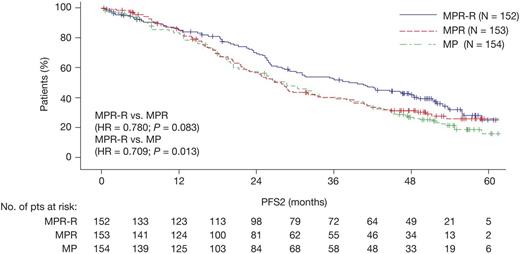Abstract
In a phase 3 trial of transplant non-eligible elderly (≥ 65 yrs) patients (pts) with NDMM, the combination of melphalan-prednisone-lenalidomide (LEN) followed by LEN maintenance (MPR-R) reduced the risk of progression by 60% compared with 9 cycles of MP (HR=0.40; P < 0.001) and by 51% compared with 9 cycles of MPR (HR=0.49; P < 0.001) (Palumbo, NEJM. 2012). The progression-free survival (PFS) benefit was seen in all patient types. With a median follow-up of 53 mos, the median overall survival (OS) was similar across the 3 treatment (Tx) groups (54 mos for MPR-R vs. 52 mos for MPR vs. 55 mos for MP) (Dimopoulos, ASH 2012; abstract 944). The similar OS benefit seen across the 3 arms could be due in part to the availability of more effective Tx options in subsequent lines of therapy. Assessment of PFS2, defined as the time from initial randomization to time of objective disease progression (PD) after next-line of therapy or death from any cause, has recently been proposed as a surrogate for OS, particularly for trials evaluating maintenance Tx (EMA guideline, www.ema.europa.eu). Therefore, data from MM-015 were analyzed to estimate PFS2 in pts treated with MPR-R, MPR, or MP.
The MM-015 study design has been previously described (Palumbo, NEJM. 2012). Refractory multiple myeloma pts who progressed during MM-015 study could receive LEN 25 mg (D1–21/28-day cycle) ± dexamethasone 40 mg (on days 1–4, 9–12, and 17–20) as part of an open-label extension phase, or any other anti-myeloma Tx outside of the protocol as part of the follow-up phase. The data of PD following 2nd-line Tx was not collected prospectively; therefore, the start of 3rd-line Tx was used as a surrogate for analyzing the PFS2 endpoint. The assessment included data up to July 31, 2012 (median follow-up: 53 mos after initial randomization).
A total of 459 pts were randomized to MPR-R (n= 152), MPR (n= 153), or MP (n= 154). At the time of the data cut-off, fewer pts in the MPR-R group had started 2nd-line Tx (53%) compared with the MPR and MP groups (77% and 82%, respectively) due to the improved PFS seen with MPR-R in the 1st-line setting. Most pts in the MP group “crossed over” to receive LEN as 2nd-line Tx (72%); choice of 2nd-line Tx in the MPR-R group was heterogeneous (Table). Median PFS2 was significantly higher with MPR-R (39.7 mos) vs. MP (28.5 mos; HR=0.71; log-rank P = 0.013) (Figure). The safety profile of continuous therapy with LEN was predictable and manageable with little evidence of cumulative toxicity and low second primary malignancy risk (Delforge, IMW 2013: abstract O-17).
2nd-line Tx received following progression in MM-015
| Variable, n (%) . | MPR-R (n = 152) . | MPR (n = 153) . | MP (n = 154) . |
|---|---|---|---|
| Any 2nd-line Txa | 81 (53) | 118 (77) | 126 (82) |
| LENb | 24 (30) | 70 (59) | 91 (72) |
| BORTb | 40 (49) | 32 (27) | 27 (21) |
| THALb | 11 (14) | 9 (8) | 6 (5) |
| Otherb,c | 31 (38) | 23 (20) | 22 (18) |
| Variable, n (%) . | MPR-R (n = 152) . | MPR (n = 153) . | MP (n = 154) . |
|---|---|---|---|
| Any 2nd-line Txa | 81 (53) | 118 (77) | 126 (82) |
| LENb | 24 (30) | 70 (59) | 91 (72) |
| BORTb | 40 (49) | 32 (27) | 27 (21) |
| THALb | 11 (14) | 9 (8) | 6 (5) |
| Otherb,c | 31 (38) | 23 (20) | 22 (18) |
Pts may have received ≥ 1 agent as 2nd-line Tx, percentages are based on the entire cohort of pts.
Percentages are based on the number of pts who received 2nd-line Tx.
Other Tx includes antineoplastic agents, bendamustine, carmustine, cyclophosphamide, doxorubicin, epirubicin, etoposide, etoposide phosphate, fotemustine, investigational drug, melphalan, monoclonal antibodies, other antineoplastic agents, vincristine, and vincristine sulfate.
BORT, bortezomib; LEN, lenalidomide; MP, melphalan + prednisone; MPR, MP + lenalidomide; MPR-R, MPR + lenalidomide maintenance; pts, patients; THAL, thalidomide; Tx, treatment.
PFS2 for MPR-R, MPR, and MP.
PFS2 was markedly improved in the MPR-R group vs. the MP group. LEN provided a durable progression-free interval also when including the impact of 2nd-line Tx, confirming the clinical benefits of continuous LEN Tx. The benefit of MPR-R was apparent regardless of subsequent Tx; long-term treatment with LEN did not affect the efficacy of subsequent therapy. Use of continuous LEN in the 1st-line setting in combination with MP is more beneficial than sequential use of MP and LEN. PFS and PFS2 were improved with MPR-R; OS was similar among the 3 Tx groups; the reason for this is unclear, but may be related to the impact of subsequent Tx (i.e., 3rd and 4th line), which was more frequently needed in the MPR and MP groups.
Dimopoulos:Orthobiotech: Honoraria; Celgene Corporation: Honoraria. Off Label Use: Lenalidomide in the frontline and maintenance treatment of multiple myeloma. Petrucci:Celgene Corporation: Consultancy, Honoraria; Janssen-Cilag: Consultancy, Honoraria; Bristol-Myers Squibb: Consultancy, Honoraria. Catalano:Celgene Corporation: Honoraria, Membership on an entity’s Board of Directors or advisory committees, Research Funding; Roche: Honoraria, Membership on an entity’s Board of Directors or advisory committees, Research Funding. Yu:Celgene Corporation: Employment, Equity Ownership. Grote:Celgene Corporation: Employment, Equity Ownership. Jacques:Celgene Corporation: Employment, Equity Ownership. Palumbo:Amgen: Consultancy, Honoraria; Bristol-Myers Squibb: Consultancy, Honoraria; Celgene: Consultancy, Honoraria; Janssen Pharmaceuticals: Consultancy, Honoraria; Millenium: Consultancy, Honoraria; Onyx: Consultancy, Honoraria.
Author notes
Asterisk with author names denotes non-ASH members.


This feature is available to Subscribers Only
Sign In or Create an Account Close Modal